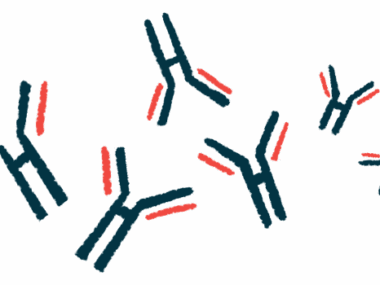Tavneos Plus Rituximab Safe and Effective in Real-world Use
Written by |

Tavneos (avacopan), in combination with rituximab, leads to high remission rates without a need for standard glucocorticoids in people with ANCA-associated vasculitis (AAV), according to a small, real-life study in France.
These findings add to results from previous clinical trials, further supporting Tavneos as an effective first-line approach for this patient population.
Data also highlighted CD163 — a protein found in certain pro-inflammatory immune cells — as a potential urine biomarker of AAV relapses and response to Tavneos, the researchers noted.
The study, “Avacopan as first-line treatment in ANCA-associated vasculitis: a steroid-sparing option,” was published as a research letter in the journal Kidney International Reports.
AAV is characterized by inflammation and damage in small blood vessels, particularly those in the kidneys, due to the production of abnormal antibodies called anti-neutrophil cytoplasmic antibodies, or ANCAs. These ANCAs mainly target one of two proteins: myeloperoxidase (MPO) and proteinase 3 (PR3).
Standard treatment consists of immunosuppressive medications, such as rituximab or cyclophosphamide, along with daily anti-inflammatory glucocorticoids, or steroids. However, prolonged use of steroid medications is associated with significant side effects.
Tavneos was recently approved in the U.S., Japan, and Europe as an add-on oral therapy to immunosuppressive treatment for adults with severe active microscopic polyangiitis and granulomatosis with polyangiitis, the two most common forms of AAV.
It works by blocking C5a, one of the most potent pro-inflammatory proteins of the complement system, a set of more than 20 blood proteins that contribute to the body’s natural immune defenses but is overly active in AAV.
By suppressing C5a, the therapy is expected to lessen AAV-associated inflammation and blood vessel damage caused by excessive complement activation.
Tavneos was developed by ChemoCentryx, which granted commercial rights in nearly all countries outside the U.S. to Vifor Pharma.
Tavneos’ approvals were based on data from the global, one-year ADVOCATE Phase 3 trial (NCT02994927), which involved 331 AAV patients and showed the therapy to be an effective alternative to the glucocorticoid prednisone.
Evidence of its safety and effectiveness in the real-word setting is still limited, with one real-life study in the Netherlands having reported favorable outcomes in eight adults with hard-to-treat AAV.
A team of researchers in France now retrospectively analyzed demographic and clinical data on nine AAV adult patients who began using Tavneos between March 2020 and September 2021 at two French university hospitals.
All patients, with a median age of 75 (range, 34–86), were treated for at least one year with Tavneos (30 mg twice daily).
Five of them (55%) were newly diagnosed with AAV, while the remaining four had experienced disease relapse at the time of Tavneos initiation. Seven patients (78%) had anti-MPO antibodies, one (11%) had anti-PR3 antibodies, and one (11%) had both anti-MPO and anti-PR3 antibodies.
All showed rapidly progressive kidney damage, and often the involvement of other organs and tissues. Most (66.7%) had severe disease, as defined by a Birmingham Vasculitis Activity Score (BVAS) of 16 or higher.
Seven patients were using rituximab in combination with glucocorticoids prior to Tavneos. Among them, glucocorticoid treatment was either stopped before Tavneos (one patient), stopped at Tavneos initiation (two patients), or tapered over a median of 19 days (range, seven to 21 days) while the other four were using Tavneos.
Over one year of treatment no deaths or relapses were reported, and disease activity, as assessed with BVAS, eased significantly as early as three months into treatment.
After one year, all but one patient (89%) achieved complete remission. This remission rate was higher than that reported in ADVOCATE (66%), “despite similar severity at [Tavneos initiation] according to the BVAS,” the researchers wrote.
This may have resulted from a lower proportion of PR3-positive patients, who are at highest risk of relapse, in this study, the team noted.
Patients’ kidney function was generally stable, with some trends toward improvement, including in the study’s one dialysis-dependent patient.
The researchers also assessed changes in urine levels of soluble CD163 in the six patients with available samples. Previous studies supported CD163 — a protein receptor found at the surface of pro-inflammatory monocytes and macrophages, two immune cell types — as a non-invasive and reliable marker of kidney inflammation and relapses in AAV.
Data showed that patients’ median CD163 levels fell significantly from 234 to 17 nanograms per millimole after one year of Tavneos treatment. Of note, the highest CD163 level at the study’s start was observed in dialysis patient, and three patients had no detectable urine CD163 levels at last follow-up.
This suggest that CD163 levels in urine are associated with “the activity of AAV in patients receiving [Tavneos] and that taking [Tavneos] is followed by rapid control of kidney inflammation,” the researchers wrote.
The combination of rituximab and Tavneos was generally well tolerated, with no new safety concerns identified, and no reports of liver damage. A serious adverse event (urinary infection) occurred in one person (11%), a proportion lower than that reported for ADVOCATE (37%).
These real-life findings “confirmed that [Tavneos] plus rituximab leads to a high rate of AAV remission and allows forgoing of [glucocorticoids],” the researchers wrote, adding that Tavneos “may now belong to first-line treatments, not only in difficult-to-treat patients.”
Data also suggest that soluble CD163 in urine may help determine the best moment to stop Tavneos in each patient.






